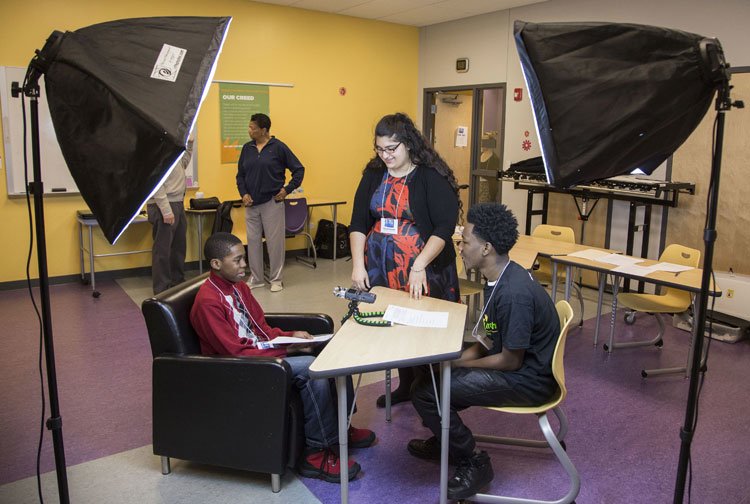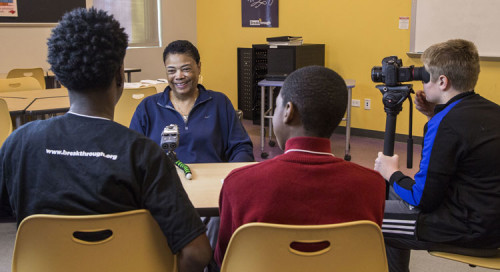
During their Chicago History Museum class last fall, DePaul students Catrien Egbert and Yasmin Mitchel were especially interested in oral histories, the collection of history through interviews.
So when their professor, Peter Alter, asked for interns for an upcoming oral history project of people who have lived in the East Garfield Park neighborhood during the past 40 years, they both wanted to be a part of it. Luckily for them, they were chosen for the internship.
“I enjoy listening to stories and having conversations with people, and this project was giving voice to people who had not had their stories told before,” said Mitchel, a junior and dramaturgy/criticism major.
All three became part of “Forty Blocks: The East Garfield Park Oral History Project,” a collaboration between the Chicago History Museum and the social service provider Breakthrough Urban Ministries, which is based in the neighborhood. Both organizations helped elementary and middle school students from the West Side area interview 23 residents for a documentary, and in doing so capture the history of East Garfield Park.
The project began in the spring of last year when Alter, who is also the director of the museum’s oral history projects, was approached by Breakthrough, which was trying to find resources about East Garfield Park. After searching through the museum’s archives, they found that since 1968, when Martin Luther King Jr. was assassinated, the neighborhood’s history was hardly documented.
“That was really the first big lightbulb moment that, ‘Hey, we’re really on to something, that it is really significant in terms of the historical documentation of the West Side, specifically East Garfield Park,’” Alter said.
The museum and Breakthrough decided to change that by recording the stories told by residents who experienced the neighborhood during the past 40 years. Besides adding to the documented history of the Chicago neighborhood, the project also strives to empower the people who live there.
“Forty blocks in particular helps all participants by telling the stories of an area that often gets stereotyped, often gets overlooked and often gets misunderstood,” Egbert, a junior history major, said. “It’s hard to talk about a lot of the issues East Garfield Park faces, but what’s interesting is that it’s not hard for the residents.”

“People really want to challenge that, and through our modest project, we were helping them provide a platform to do that,” Alter said.
By the time winter arrived, Breakthrough and the museum were hard at work to accomplish their goals. While Breakthrough found residents who wanted to share their stories, interns Egbert and Mitchel did their part to prepare the team for the upcoming interviews.
As interns, Egbert and Mitchel helped raise over $4,500 through Kickstarter to fund the project, promoted it on social media, carried out research, drafted questions and taught the students how to interview the residents.
While their Chicago History Museum class briefly touched on oral history, Egbert said most of the skills they needed for the internship were learned by “diving straight in.”
“I was surprised by how the lack of preparation helped Yasmin and I to do better, because we had to lean on each other,” Egbert said. Alter would give them the resources and tell them to “go at it.”
“There really is no possible way that it could have happened without their work,” Alter said.
The students also seemed to be enthralled by the oral history project. Some were interested in the filming aspect, some in interviewing and others in history, Egbert said.
“The kids were incredibly bright and dedicated individuals who had a genuine curiosity and passion for their neighborhood,” Egbert said.
Once they were prepared, the students began interviewing the residents in March at the FamilyPlex, Breakthrough’s facility in East Garfield Park. They were split up into three teams of nine students, one led by Mitchel, one by Egbert and one by Carrie Shepard of WBEZ. Each interview lasted about 30 minutes, for a total of about 12 hours of recording.
A variety of people from the community were interviewed, including long-term residents, the elderly, reverends and DePaul alumna Dorothy Gaters, who has been head coach of Marshall High School’s girls basketball team since 1976.
“Whenever we would ask them more about their experiences, they would always be like, ‘Well, how much time do you got? No one has ever asked me this question before,’” Mitchel said.
Mitchel noticed that while the residents told their stories, they seemed to be also reliving them.
“It’s still real to them. You could see the expressions on their faces while they had flashbacks,” Mitchel said. Learning about those different perspectives was one of the most enjoyable parts of the internship, Mitchel said.
Egbert noticed that the residents, in telling their experiences of East Garfield Park, often brought up issues of gentrification, race relations, housing and education.
“It’s a history that lends itself very easily to contemporary issues,” Egbert said. “So you can trace back and see issues that exist today.”
The residents also seemed to take enormous pride in their community organizations, Egbert said, such as the Gold Dome Building, where residents can partake in a variety of educational activities.
Now that the bulk of the interviews are finished, Breakthrough is putting together the 20-minute documentary, which will contain footage from the interviews and premiere in July at the Chicago History Museum.
Meanwhile, the recordings the museum now has are being transcribed and uploaded into its archives. From there, the curious can read the transcripts and listen to the recordings.
In retrospect, Egbert said oral history is one of the best ways to tell peoples’ stories from communities like East Garfield Park.
“You hear the people, you hear how they stutter, you hear how they pause, you hear how they tell the story in their own words,” Egbert said. “I think that is a very profound and a very useful way to tell history.”

